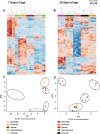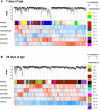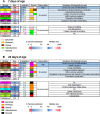Transcriptional analysis of adipose tissue during development reveals depot-specific responsiveness to maternal dietary supplementation
- PMID: 29941966
- PMCID: PMC6018169
- DOI: 10.1038/s41598-018-27376-3
Transcriptional analysis of adipose tissue during development reveals depot-specific responsiveness to maternal dietary supplementation
Abstract
Brown adipose tissue (BAT) undergoes pronounced changes after birth coincident with the loss of the BAT-specific uncoupling protein (UCP)1 and rapid fat growth. The extent to which this adaptation may vary between anatomical locations remains unknown, or whether the process is sensitive to maternal dietary supplementation. We, therefore, conducted a data mining based study on the major fat depots (i.e. epicardial, perirenal, sternal (which possess UCP1 at 7 days), subcutaneous and omental) (that do not possess UCP1) of young sheep during the first month of life. Initially we determined what effect adding 3% canola oil to the maternal diet has on mitochondrial protein abundance in those depots which possessed UCP1. This demonstrated that maternal dietary supplementation delayed the loss of mitochondrial proteins, with the amount of cytochrome C actually being increased. Using machine learning algorithms followed by weighted gene co-expression network analysis, we demonstrated that each depot could be segregated into a unique and concise set of modules containing co-expressed genes involved in adipose function. Finally using lipidomic analysis following the maternal dietary intervention, we confirmed the perirenal depot to be most responsive. These insights point at new research avenues for examining interventions to modulate fat development in early life.
Conflict of interest statement
The authors declare no competing interests.
Figures





Similar articles
-
Global gene expression profiling of brown to white adipose tissue transformation in sheep reveals novel transcriptional components linked to adipose remodeling.BMC Genomics. 2015 Mar 19;16(1):215. doi: 10.1186/s12864-015-1405-8. BMC Genomics. 2015. PMID: 25887780 Free PMC article.
-
UCP1 is present in porcine adipose tissue and is responsive to postnatal leptin.J Endocrinol. 2014 Oct;223(1):M31-8. doi: 10.1530/JOE-14-0155. Epub 2014 Aug 13. J Endocrinol. 2014. PMID: 25122002
-
Brown adipose tissue genes in pericardial adipose tissue of newborn sheep are downregulated by maternal nutrient restriction in late gestation.Pediatr Res. 2013 Sep;74(3):246-51. doi: 10.1038/pr.2013.107. Epub 2013 Jun 20. Pediatr Res. 2013. PMID: 23788058
-
The developmental transition of ovine adipose tissue through early life.Acta Physiol (Oxf). 2014 Jan;210(1):20-30. doi: 10.1111/apha.12053. Epub 2013 Jan 28. Acta Physiol (Oxf). 2014. PMID: 23351024 Review.
-
Dietary Factors Promoting Brown and Beige Fat Development and Thermogenesis.Adv Nutr. 2017 May 15;8(3):473-483. doi: 10.3945/an.116.014332. Print 2017 May. Adv Nutr. 2017. PMID: 28507012 Free PMC article. Review.
Cited by
-
Developmental programming: Adipose depot-specific regulation of non-coding RNAs and their relation to coding RNA expression in prenatal testosterone and prenatal bisphenol-A -treated female sheep.Mol Cell Endocrinol. 2023 Mar 15;564:111868. doi: 10.1016/j.mce.2023.111868. Epub 2023 Jan 26. Mol Cell Endocrinol. 2023. PMID: 36708980 Free PMC article.
-
CARDIAL-MS (CArdio-Renal-DIAbetes-Liver-Metabolic Syndrome): a new proposition for an integrated multisystem metabolic disease.Diabetol Metab Syndr. 2025 Jun 16;17(1):218. doi: 10.1186/s13098-025-01796-4. Diabetol Metab Syndr. 2025. PMID: 40524210 Free PMC article. Review.
-
Epicardial adipose tissue in contemporary cardiology.Nat Rev Cardiol. 2022 Sep;19(9):593-606. doi: 10.1038/s41569-022-00679-9. Epub 2022 Mar 16. Nat Rev Cardiol. 2022. PMID: 35296869 Free PMC article. Review.
-
Aging Effects on Epicardial Adipose Tissue.Front Aging. 2021 May 13;2:666260. doi: 10.3389/fragi.2021.666260. eCollection 2021. Front Aging. 2021. PMID: 35822028 Free PMC article. Review.
-
Transcriptomic evidence that cortisol alters perinatal epicardial adipose tissue maturation.Am J Physiol Endocrinol Metab. 2019 Oct 1;317(4):E573-E585. doi: 10.1152/ajpendo.00007.2019. Epub 2019 Jul 19. Am J Physiol Endocrinol Metab. 2019. PMID: 31322429 Free PMC article.
References
Publication types
MeSH terms
Substances
Grants and funding
- BB/E01772X/1/BB_/Biotechnology and Biological Sciences Research Council/United Kingdom
- BBS/B/1356X/BB_/Biotechnology and Biological Sciences Research Council/United Kingdom
- BB/I001271/1/BB_/Biotechnology and Biological Sciences Research Council/United Kingdom
- BB/E022758/1/BB_/Biotechnology and Biological Sciences Research Council/United Kingdom
- G17764/BB_/Biotechnology and Biological Sciences Research Council/United Kingdom
LinkOut - more resources
Full Text Sources
Other Literature Sources
Medical

